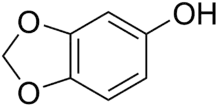 | |
| Names | |
|---|---|
| Preferred IUPAC name
2H-1,3-Benzodioxol-5-ol | |
| Other names
1,3-Benzodioxol-5-ol Benzo[d][1,3]dioxol-5-ol Sesamol 3,4-Methylenedioxyphenol | |
| Identifiers | |
3D model (JSmol) |
|
| ChemSpider | |
| ECHA InfoCard | 100.007.784 |
| KEGG | |
PubChem CID |
|
| UNII | |
CompTox Dashboard (EPA) |
|
| |
| |
| Properties | |
| C7H6O3 | |
| Molar mass | 138.12 g/mol |
| Melting point | 62 to 65 °C (144 to 149 °F; 335 to 338 K) |
| Boiling point | 121 to 127 °C (250 to 261 °F; 394 to 400 K) at 5 mmHg |
| Hazards | |
| NFPA 704 (fire diamond) | |
Except where otherwise noted, data are given for materials in their standard state (at 25 °C [77 °F], 100 kPa).
Infobox references | |
Sesamol is a natural organic compound which is a component of sesame seeds and sesame oil, with anti-inflammatory, antioxidant, antidepressant and neuroprotective properties. It is a white crystalline solid that is a derivative of phenol. It is sparingly soluble in water, but miscible with most oils. It can be produced by organic synthesis from heliotropine.
Sesamol has been found to be an antioxidant that may prevent the spoilage of oils.[2][3] It also may prevent the spoilage of oils by acting as an antifungal.[4] It can be used in the synthesis of paroxetine.[5]: 138–141
Sesamol's molecular targets and mechanism of action, at least for its antidepressant-like effects, is found to be through the brain nerve growth factor (NGF) and endocannabinoid signalling under the regulatory drive of the CB1 receptors.[6]
Alexander Shulgin used sesamol in his book PiHKAL to make MMDA-2.
See also
References
- ↑ Sesamol Archived 2010-01-14 at the Wayback Machine at Chemicalland21.com
- ↑ Kim JY, Choi DS, Jung MY (May 2003). "Antiphoto-oxidative activity of sesamol in methylene blue- and chlorophyll-sensitized photo-oxidation of oil". Journal of Agricultural and Food Chemistry. 51 (11): 3460–5. doi:10.1021/jf026056p. PMID 12744684.
- ↑ Ohsawa T (1991). "Sesamol and sesaminol as antioxidants". New Food Industry. 33 (6): 1–5.
- ↑ Wynn JP, Kendrick A, Ratledge C (June 1997). "Sesamol as an inhibitor of growth and lipid metabolism in Mucor circinelloides via its action on malic enzyme". Lipids. 32 (6): 605–10. doi:10.1007/s11745-997-0077-1. PMID 9208389. S2CID 4015004.
- ↑ Li JJ (2004). Contemporary drug synthesis. Hoboken, N.J.: Wiley. ISBN 978-0-471-21480-9.
- ↑ Hassanzadeh P, Hassanzadeh A (October 2013). "Implication of NGF and endocannabinoid signaling in the mechanism of action of sesamol: a multi-target natural compound with therapeutic potential". Psychopharmacology. 229 (4): 571–578. doi:10.1007/s00213-013-3111-z. PMID 23624775. S2CID 253748878.
